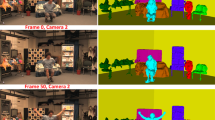Abstract
We present a novel algorithm for 3D reconstruction in this paper, converting incremental 3D reconstruction to an optimization problem by combining two feature-enhancing geometric priors and one photometric consistency constraint under the Bayesian learning framework. Our method first reconstructs an initial 3D model by selecting uniformly distributed key images using a view sphere. Then once a new image is added, we search its correlated reconstructed patches and incrementally update the result model by optimizing the geometric and photometric energy terms. The experimental results illustrate our method is effective for incremental 3D reconstruction and can be further applied for large-scale datasets or to real-time reconstruction.







Similar content being viewed by others
References
Furukawa Y, Ponce J (2010) Accurate, dense, and robust multi view stereopsis. IEEE Trans Pattern Anal Mach Intell 32(8):1362–1376
Pons J-P, Keriven R, Faugeras OD (2007) Multi-view stereo reconstruction and scene flow estimation with a global image-based matching score. Int J Comput Vis 72(2):179–193
Tran S, Davis L (2006) 3d surface reconstruction using graph cuts with surface constraints. In: European conference on computer vision (ECCV), pp 219–231
Vogiatzis G, Torr PH, Cipolla R (2005) Multi-view stereo via volumetric graph-cuts. In: Computer vision and pattern recognition (CVPR), pp 391–398
Hornung A, Kobbelt L (2006) Hierarchical volumetric multi-view stereo reconstruction of manifold surfaces based on dual graph embedding. In: Computer vision and pattern recognition (CVPR), pp 503–510
Lowe D (2004) Distinctive image features from scale-invariant keypoints. Int J Comput Vis 60(2):91–110
Hernández Esteban C, Schmitt F (2004) Silhouette and stereo fusion for 3D object modeling. Comput Vis Image Underst 96(3):367–392
Furukawa Y, Ponce J (2009) Carved visual hulls for image-based modeling. Int J Comput Vis 81(1):53–67
Goesele M, Curless B, Seitz SM (2006) Multi-view stereo revisited. In: Computer vision and pattern recognition (CVPR), pp 2402–2409
Strecha C, Fransens R, Gool LV (2006) Combined depth and outlier estimation in multi-view stereo. In: Computer vision and pattern recognition (CVPR), pp 2394–2401
Chawla NV, Bowyer KW, Hall LO, Kegelmeyer WP (2002) SMOTE: synthetic minority over-sampling technique. J Artif Intell Res 16:321–357
Diebel JR, Thrun S (2006) A Bayesian method for probable surface reconstruction and decimation. ACM Trans Graph 25(1):39–59
http://www.cs.washington.edu/homes/furukawa/research/mview/index.html
Furukawa Y, Curless B, Seitz SM, Szeliski R (2010) Towards Internet-scale multi-view stereo. In: Computer vision and pattern recognition (CVPR), pp 1434–1441
Furukawa Y, Ponce J (2009) Accurate camera calibration from multi-view stereo and bundle adjustment. Int J Comput Vis 84(3):257–268
Klein G, DW Murray (2007) Parallel tracking and mapping for small AR workspaces. In: International symposium on mixed and augmented reality (ISMAR), pp 225–234
Davison AJ, Reid ID, Molton ND, Stasse O (2007) MonoSLAM: real-time single camera SLAM. IEEE Trans Pattern Anal Mach Intell 29(6):1052–1067
Davison A (2003) Real-time simultaneous localization and mapping with a single camera. In: International conference on computer vision (ICCV), pp 1403–1410
Eade E, Drummond T (2006) Scalable monocular SLAM. In: Computer vision and pattern recognition (CVPR), vol 1, pp 469–476
Merrell P, Akbarzadeh A, Wang L, Mordohai P, Frahm J, Yang R, Nistér D, Pollefeys M (2007) Real-time visibility-based fusion of depth maps. In: International conference on computer vision (ICCV), pp 1–8
Pollefeys M, Nistér D, Frahm J-M, Akbarzadeh A, Mordohai P, Clipp B, Engels C, Gallup D, Kim SJ, Merrell P, Salmi C, Sinha SN (2008) Detailed real-time urban 3D reconstruction from video. Int J Comput Vis 78(o):2–3. 143–167
Lovi D, Birkbeck N, Cobzas D, Jägersand M (2010) Incremental free-space carving for real-time 3D reconstruction. In: Fifth international symposium on 3D data processing visualization and transmission (3DPVT)
Hilton A (2005) Scene modeling from sparse 3D data. Image Vis Comput 23(10):900–920
Pan Q, Reitmayr G, Drummond T (2009) ProFORMA: probabilistic feature-based on-line rapid model acquisition. In: British machine vision conference (BMVC)
Nistér D, Naroditsky O, Bergen JR (2004) Visual odometry. In: Computer vision and pattern recognition (CVPR), pp 652–659
Agarwal S, Snavely N, Seitz SM, Szeliski R (2010) Bundle adjustment in the large. In: European conference on computer vision (ECCV), pp 29–42
Osada R, Funkhouser TA, Chazelle B, Dobkin DP (2002) Ops shape distributions. ACM Trans Graph 21(4):807–832
Thang ND, Kim T-S, Lee Y-K, Lee S (2011) Estimation of 3-D human body posture via co-registration of 3-D human model and sequential stereo information. Appl Intell 35(2):163–177
Kang J-G, Kim S, An S-Y, Oh S-Y (2012) A new approach to simultaneous localization and map building with implicit model learning using neuro evolutionary optimization. Appl Intell 36(1):242–269
Bonev B, Cazorla M, Martín F, Matellán V (2012) Portable autonomous walk calibration for 4-legged robots. Appl Intell 36(1):136–147
Bayrak AG, Polat F (2012) Formation preserving path finding in 3-D terrains. Appl Intell 36(2):348–368
Acknowledgements
The work described in this paper was supported by the Natural Science Foundation of China under Grant No. 61272218 and 61021062, the 973 Program of China under Grant No. 2010CB327903, and the Program for New Century Excellent Talents under NCET-11-0232.
Author information
Authors and Affiliations
Corresponding author
Rights and permissions
About this article
Cite this article
Yuan, ZH., Lu, T. Incremental 3D reconstruction using Bayesian learning. Appl Intell 39, 761–771 (2013). https://doi.org/10.1007/s10489-012-0410-8
Published:
Issue Date:
DOI: https://doi.org/10.1007/s10489-012-0410-8




